Christmas is here! Finally! I’ve been really looking forward to the holidays. I can’t wait to turn the laptop off and completely disconnect from anything lab related!
My husband and I decided to go to NYC to spend the holidays instead of going to our home countries. And to be honest, I think it was the best decision. 2018 has been an eventful year, good and bad stuff happened, tears of joy and tears of sorrow. We need a break, a real one. Like a big apple break! Which means I’m not cooking anything for Christmas!
However, I know many people will, and you’ll be looking to impress your guests.
So *guest* what?? (Did you see what I did there? Lol)

It’s panettone time!!!!
Okay, let me say this. It’s NOT the original recipe and I didn’t use any type of
I’ve been working on this recipe for quite a long time. This dough was difficult to handle. But there was something I was NOT going to give up on. And that’s the eggs and sugar content. Which is exactly what makes this dough so difficult to handle. But panettone has to have a strong aroma of eggs, and the yellow color, and it has to be sweet and rich and full of flavor! And it has to last fresh for a long time! Because, let’s be honest. We don’t want to go through all this work for just a couple of days of fresh panettone.
NOPE!
Now.. you do need a strong flour for this: A protein content of at the very least 14-15%.
I could’ve bough the flour online. But I wanted to try something that could be a solution for when you need high gluten flour and you forgot to order it online or you want to save some money in the long run.
I made my own high gluten flour. How? By adding more gluten!
I have wheat gluten at home because I use it to make plant base “meat”. So, what I did was: I first calculated the total amount of gluten in my recipe using a 15% protein flour. Then I calculated the actual protein content of my flour and the gluten I have. And finally, I calculated how much gluten I had to add to my flour.
I know, it sounds weird all these calculations. Don’t worry, I did the calculations for you, so you don’t have to do it. I’ll add another post on how to do it.
Once I adjusted the ingredients to the size of my molds, I tried the recipe with my flour that has 12.7% protein content. It didn’t go very well, I ended up with a cake-like crumb rather than bread.
I tried again adding the gluten. based The quality of the crumb really improved, and the panettones were fresh for 2 weeks at least! (We didn’t have any left after 2 weeks!).
WHAT’S WRONG WITH YOUR FLOUR?
Nothing. Absolutely nothing. However, think about the amount of eggs and sugar and butter panettones have. There are so many things in between the gluten molecules that it’s extremely difficult to develop the gluten network. If you do it by hand it’s going to take you forever. If you use a stand mixer you’ll have to knead the dough for a long long time, and that means that the stand mixer will transfer heat to the dough and make it too soft, and you’ll also take the risk of over kneading the dough. Because stand mixers don’t knead homogeneously. So, chances are that some parts of the dough won’t have good gluten development while other parts will be over kneaded. Long story short, the whole structure will be destroyed.
That’s why we need more protein! If there are more gluten proteins, there are more chances they’ll find each other among all the sugars and fats. Which means, you don’t have to put in such an arduous work to knead the dough, and you reduce the risk of over-kneading it
Don’t smile, it’s still gonna be tough enough lol
BACK TO THE RECIPE!
A panettone is a masterpiece. And you have to do it step by step. No rush. So pick a day that you’ll be home and you’ll have time. You can also make this bread a couple of days ahead of time. Just keep it in a plastic bag so it won’t dry out.
My recipe has two pre-ferments and the final dough. In a warm kitchen you can get it done the same day. Or you can even retard the bulk fermentation overnight in the fridge.
NOTE 1: If you don’t have the high protein flour and you decided to add gluten, make sure you mix it very well with the flour first, otherwise the moment it gets in contact with a liquid it’ll start forming the network and you won’t be able to properly mix the ingredients.
SOAKING THE FRUITS
For this recipe I used golden and dark raisins, candied orange and dried apricots.
I make the candied orange at home and I made this batch barely 1 month ago, they’re still soft, so I did not soak the orange, but I did soak the rest.
In a
I like to start soaking the fruits 1 day in advance, but if you don’t have time or forgot about it, just start soaking the fruits when you start the process. They’ll have enough time to get soft. Plus, the moisture of the dough will also help during the fermentation.
PREFERMENT 1
Once you have your flour ready, add the yeast to the water and let it sit while you whisk the eggs. Then mix the eggs, and the yeast mixture and give it a whisk. It must be very homogenous. Then add the flour and mix very well.
You should have something like a thick pancake batter. Not quite a dough.
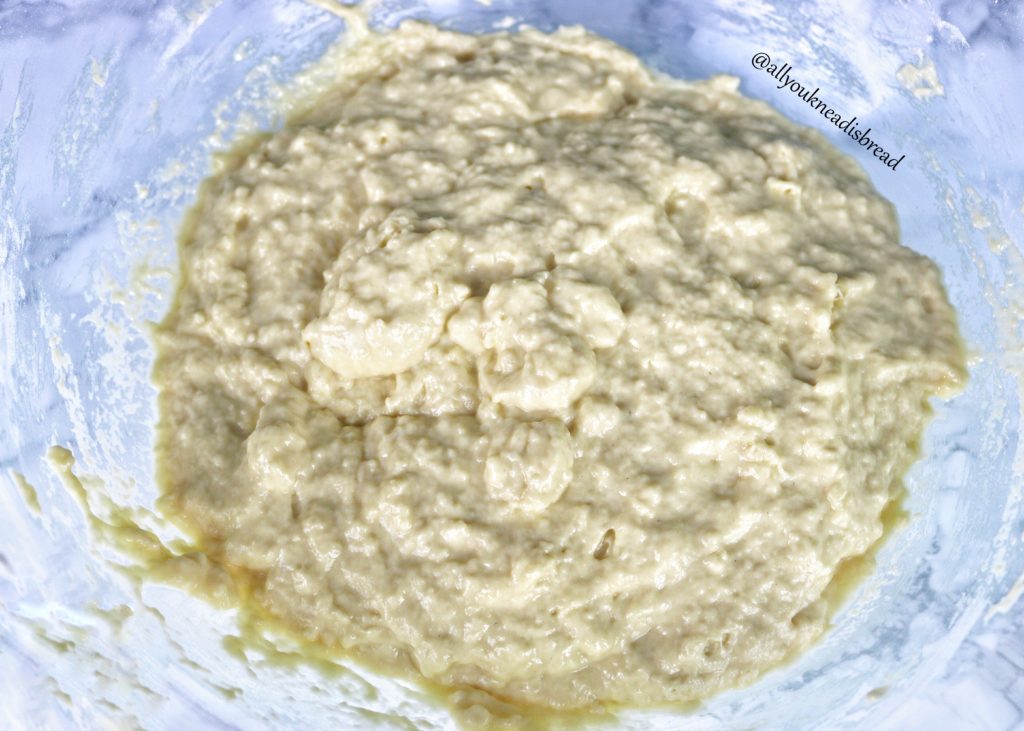
When everything is well mixed transfer it to a tall pitcher, mine is 2.5 or 3 qt. And let this preferment rise until it triples or quadruples in size. Look for a place in your house where it’s not too cold. It’ll take some time to start growing. Be patient!
When you see the preferment is all the way to the edges of your pitcher, use your wire whisk or a spatula and try to deflate it a bit. Mine took about 1h 30 mins to 2h approx.

PREFERMENT 2
On another big bowl add the egg yolks and the sugar and mix it very well until you see the eggs getting whiter and fluffy. Then add the honey, the orange syrup (if you have) and the orange, lime and lemon zest and mix thoroughly. Then add the flour (with the gluten mixed already if using this method) and mix again.

Now add the preferment 1 and mix everything very well until you don’t have big lumps and both batters are well integrated. Cover the bowl and let it rise until it triples or quadruples in size. I left mine go up to the bowl edges. This preferment rises quicker

When preferment 2 is ready, time to roll up our sleeves and start working the dough!
FINAL DOUGH
On this
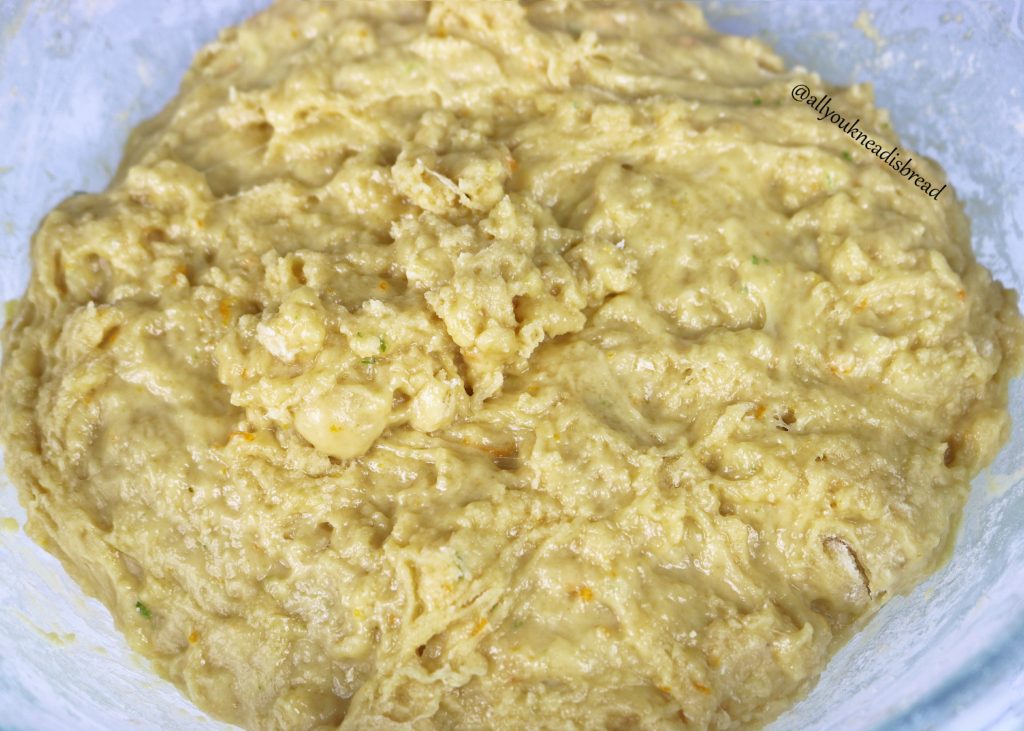
Now… start the workout! I used my stand mixer first. I used the paddle attachment on speed 3 (of 10 total speeds) for about 20 minutes or maybe a bit more. For doughs this sticky, I find the paddle attachment much more efficient to start developing the dough.
NOTE 2: If you’re using a stand mixer, be careful, when the dough starts getting some consistency, it can come up through the hook and get in between the moving parts. Just keep an eye on it!
NOTE 3: The paddle attachment is going to speed things up because the dough is too soft and somehow runny/sticky so the paddle will apply more pressure and will help develop the gluten network better at the beginning.
When I saw the dough was strong enough to pull itself from the bottom of the bowl I stopped and started to add the butter manually. Adding a bit of butter and squeezing it until it was absorbed.
You will notice the change in the consistency!
Keep kneading until the gluten has been developed properly. The dough should be very elastic and you should be able to stretch it without tearing it.
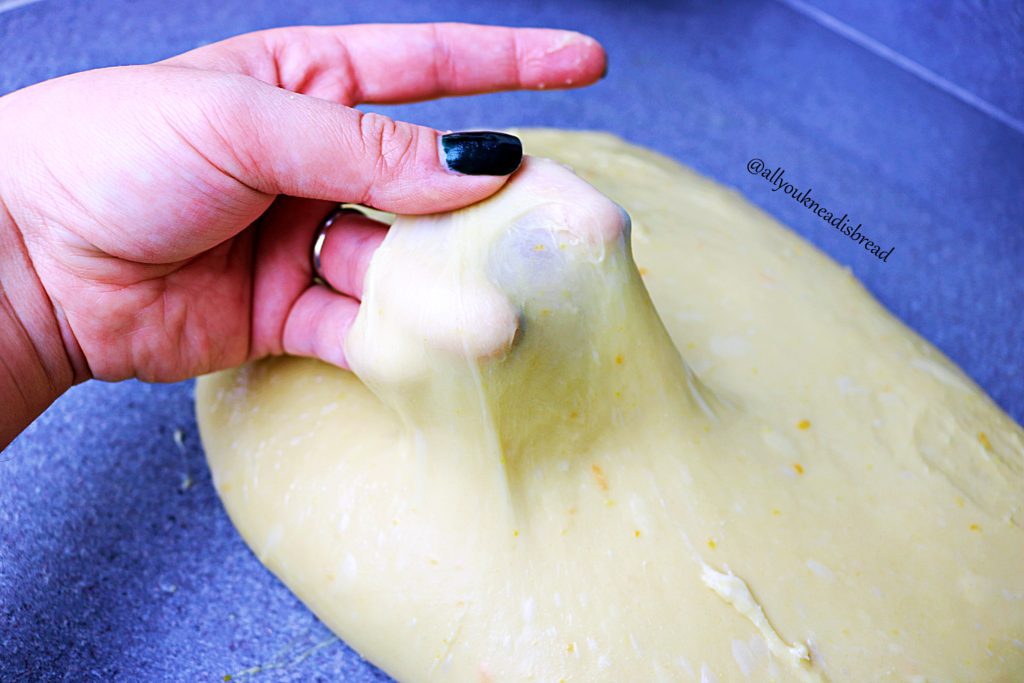
When the dough is good, let it rest 5 mins and then add the fruits. Don’t knead it too much, just enough to make sure the fruits are well distributed.

Put the dough in a lightly oiled bowl and let it ferment!
Look at how thin you can stretch the dough. That’s a sign of a proper gluten development
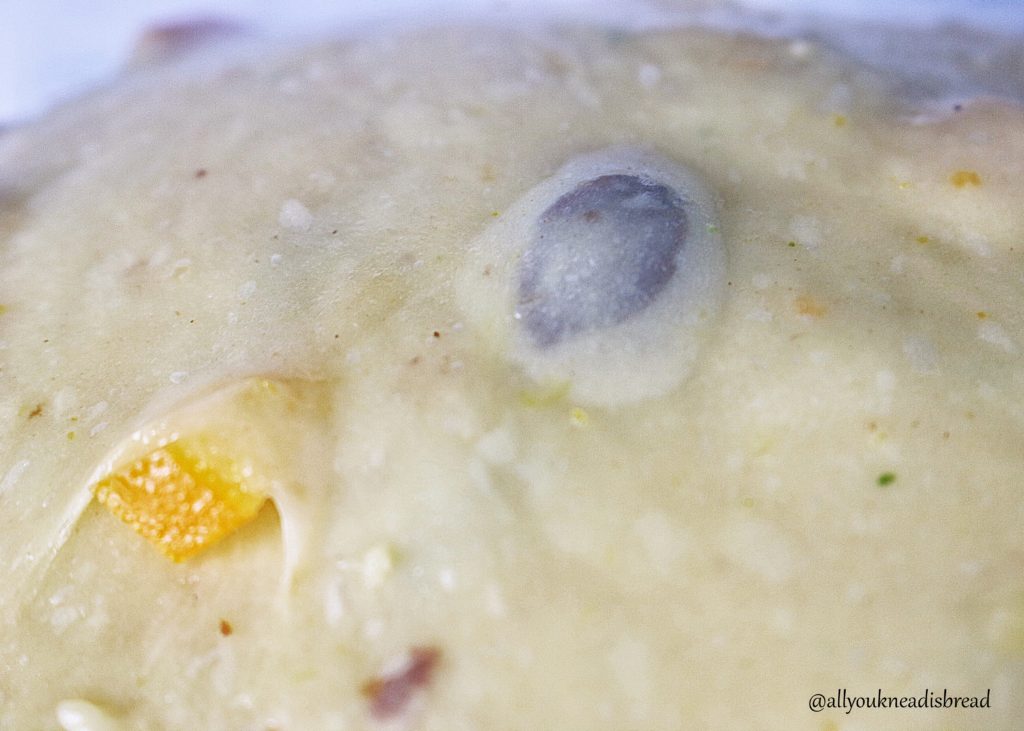
OPTIONAL STEP: If you think your dough is delicate you can do 3 sets of stretch and folds every 25 mins to improve the structure without destroying it.
At this point, you can place the dough in the fridge for
Let the dough rise until it doubles in size. Then deflate the dough and separate it in two equal parts.
Pre-shape each part into a ball to create some tension and put them in the panettone molds. My molds are the largest ones (6″ x 4½”). The dough should occupy 3/4 of the total volume of the mold.
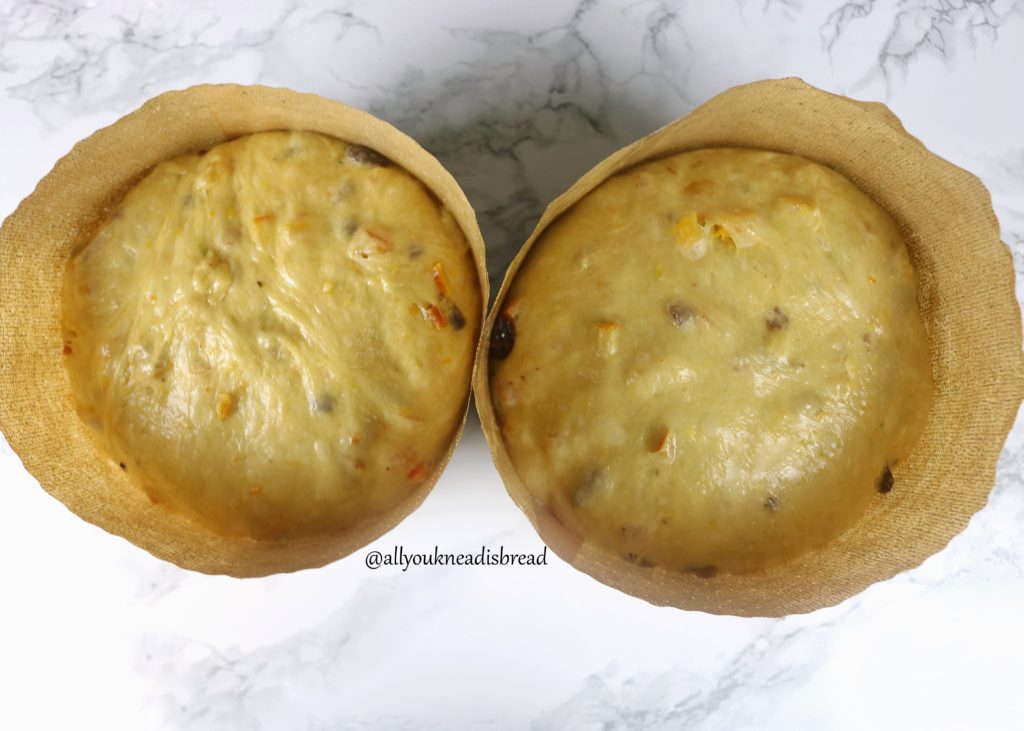
Preheat your oven at 350F and, in the meanwhile, let the panettones rise until the dough reaches the rim of the mold.

Make a cut on the top of each panettone and open it up a little bit

Now add a little bit of butter inside of the cut

Put the panettones in the oven and turn the oven down to 325F. This way the browning reactions won’t occur too fast.
Bake until they’re ready and immediately after baking insert a skewer in the bottom part of the panettones and hang them upside down until they cool down completely
This step is important because it’ll make sure the crumb and structure are not compromised. After baking the crumb is still finishing cooking, but it’s also too soft and too heavy, so you must be careful, or the panettones could collapse!
Once they cooled down… enjoy this Christmas delicacy! With all the work, I’m sure you’ll enjoy them even more!

Look at this crumb! Fantastic! So cohesive and soft and yellow and it smells so good!

Let me know if you make these panettones or if you have any suggestion/ doubt etc.
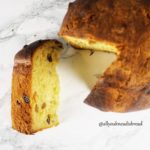
Homemade Christmas Panettone
Ingredients
Dried fruits
- 180 g candied orange
- 110 g black raisins
- 110 g golden raisins
- 100 g dried apricots
- 40 g brown rum
Preferment 1
- 470 g bread flour
- 21 g vital wheat gluten
- 390 g water
- 3 L eggs
- 7 g active dry yeast
Preferment 2
- 200 g bread flour
- 10 g vital wheat gluten
- 5 L egg yolks
- 2 tbsp honey
- 2 tbsp orange syrup
- 100 g sugar
- 1 orange zest
- 1 lemon zest
- 1 lime zest
Dough
- 260 g bread flour
- 15 g vital wheat gluten
- 180 g sugar
- 10 g salt
- 227 g butter (2 sticks)
- 2 tbsp vanilla extract (or 2 vanilla beans)
Instructions
Dried fruits
-
Mix the raisins and apricot with the rum 24h prior baking. Shaking the container once in a while to make sure the liquid is distributed evenly.
Preferment 1
-
Mix the flour and the vital gluten
-
Dissolve the yeast in the water and let it sit for 10 minutes
-
Whisk the eggs into the yeast solution and mix very well
-
Add the flour mixture and mix until there are no dry particles
-
Let rise until it triples or quadruples its size
Preferment 2
-
Mix the flour and the vital gluten
-
Whisk the egg yolks until they thicken up a bit
-
Add the honey and orange syrup and mix them very well
-
Add the citrus zest
-
Add preferment 1 and mix very well until there are no big lumps
-
Let rise until it triples its size
Dough
-
Deflate the preferment 2 and add the sugar, vanilla extract. Mix everything very well
-
Mix the flour and the vital gluten
-
Add the flour mixture to the preferment 2 and mix thoroughly until you don’t see dry flour particles and let it rest 20 mins
-
Start kneading. About 20 mins on speed 3 with the paddle attachment of your stand mixer and later use the hook or by hand until the dough gets some consistency. I took 20-25 more minutes
-
Add the butter little by little and keep kneading until its elastic
-
Add the fruits and knead just enough to integrate them into the dough.
-
Place the dough in an oiled container and let ferment until it doubles in size (you can do this step overnight in the fridge)
-
Deflate the dough and separate it into 2 equal pieces
-
Preshape the pieces into balls and place them in the molds
-
Preheat your oven at 350 F
-
Cover the panettones with an oiled plastic wrap and let rise until it reaches the top of the mold
-
Make a cut on the panettones and add a little chunk of butter
-
Put the panettones in the oven and lower the temperature to 325F
-
Bake for about 55 minutes or until they’re brown outside and completely cooked inside.
-
Right after baking insert a skewer through each panettone and turn upside down. Let them cool down completely
Happy Holidays!


Wow this recipe looks amazing! I can almost smell the freshly baked panettone 🙂
I’m going to make this as a christmas gift and was wondering – if I wanted to swap the raisins and apricots for pistachios, dark chocolate and dried figs, would you recommend keeping the total weight of the dried fruits/nuts the same? Any suggestions would be so helpful!
If you use strong enough flour and your gluten is strong, it should be fine since the weight is the same. But if you’re worried it could collapse add a little less just to be safe!
Thanks so much for your reply! I’m going to try this tomorrow 🙂
Good luck!!!